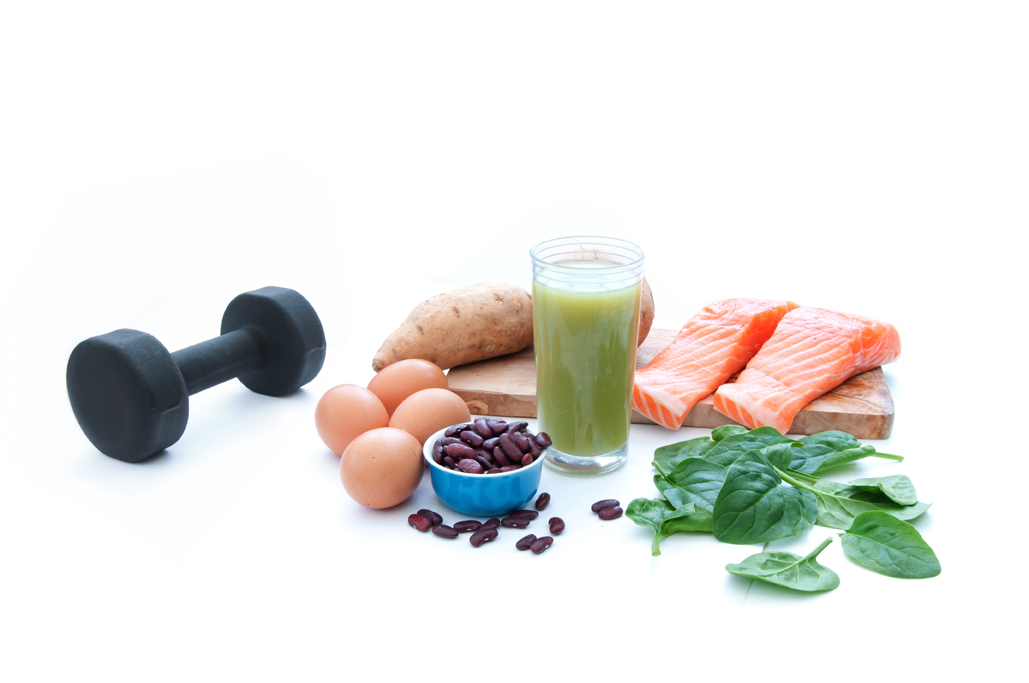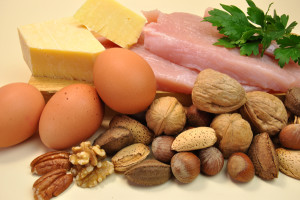I am often reminded of when my son shared with me a discussion from his fifth-grade class. His teacher, who up until that point he had thought infallible, taught erroneous information about sources of protein. He knew the information was incorrect, but was afraid to offer his input for fear of being labeled a “nerd.” Now, many years later, I am still amazed at how many people do not have even a basic understanding of nutrition. I also think one of the most misunderstood aspects of nutrition is protein—especially protein needs of mature adults.
 Proteins
Proteins
Proteins are essential parts of organisms and are involved in virtually every process within cells. Many proteins are enzymes that catalyze biochemical reactions and are vital to metabolism. Proteins also have structural or mechanical functions, such as actin and myosin in muscle and the proteins in the cytoskeleton, which form a system of scaffolding that maintains cell shape. Other proteins are important in cell signaling, immune responses, cell adhesion, and the cell cycle. Proteins are also necessary in our diets, since we cannot synthesize all the amino acids needed and must obtain al the essential amino acids from foods. (Note: Amino acids are the building blocks from which proteins are made.) Through the process of digestion, ingested protein is broken down into free amino acids that are then used in metabolism.
Proteins contain 4 calories per gram. This is an average, as each protein is slightly different (range roughly 3.5-4.5). Of the 22 amino acids involved in human nutrition, 9 are termed “essential” because they cannot be made by the body and therefore must be supplied daily in the food we eat. The rest, which the body can synthesize, are called “non-essential.” The essential amino acids are leucine, isoleucine, valine, lysine, threonine, tryptophan, methionine, phenylalanine, and histidine. A complete protein is a source of protein that contains an adequate proportion of all of the essential amino acids for our dietary needs. This does not refer to the protein source only containing all the essential amino acids, but also containing them in adequate proportion for use by the human body. A source may contain all essential amino acids, but contain one in lower proportion to the others, making it an incomplete protein.
Most animal sources and certain vegetable sources have the complete complement of all the essential amino acids in adequate proportions. Generally, proteins derived from animal foods (meats, fish, poultry, cheese, eggs, yogurt, and milk) are complete. However, proteins derived from plant foods (legumes, grains, and vegetables) tend to be limited in essential amino acids. Thus, a variety of protein sources in the diet is one way of assuring that the body’s amino acid needs are met. All the essential amino acids can be obtained on their own from various everyday plant sources, which do not need to be combined in the same meal.
The Protein Digestibility Corrected Amino Acid Score (PDCAAS) is a method of evaluating protein quality based on both the amino acid requirements of humans and their ability to digest it. Complete protein foods that obtain the highest possible PDCAAS score of 1.0 are proteins from milk sources (caseinates), egg whites, and soy protein isolate. Other foods, such as amaranth, buckwheat, hempseed, meat, poultry, soybeans, quinoa, seafood, and spirulina also are complete protein foods, but do not obtain a PDCAAS score of 1.0.
Protein Consumption
When protein is metabolized, the nitrogen is released and flushed out by the kidneys. Comparing nitrogen IN (protein intake) with nitrogen OUT (in urine) is the standard method of determining whether a person is getting the right amount of protein. For adults, nitrogen-in should match nitrogen-out. If you are losing less nitrogen than you are consuming in food, you are retaining protein. Retaining protein is normal for kids who are growing or for someone who is building muscle through strength training. But, losing more nitrogen than you consume means protein-rich tissue (mostly muscle), is breaking down. There are many potential causes for this, such as illness, stress, or chronic inactivity.
 The current recommendation for protein intake for healthy adults is 0.8 g protein per kilogram of body weight per day. This number was determined using studies on healthy young adults. But consider that body composition changes as people get older. Once adults pass the physical prime of their teens and 20’s, they lose an average of 10 ounces of lean body mass a year. This is mostly in the form of muscle tissue. Few people actually lose 10 ounces of weight a year. Instead, most gain about a pound a year, so the loss of lean tissue is masked. Another way to look at this is the average person gains about 1 pound and 10 ounces of body fat per year. This phenomenon, called sarcopenia, is derived from Greek words for “vanishing flesh.” This change in body composition contributes to impaired wound healing, loss of skin elasticity, and an inability to fight infection.
The current recommendation for protein intake for healthy adults is 0.8 g protein per kilogram of body weight per day. This number was determined using studies on healthy young adults. But consider that body composition changes as people get older. Once adults pass the physical prime of their teens and 20’s, they lose an average of 10 ounces of lean body mass a year. This is mostly in the form of muscle tissue. Few people actually lose 10 ounces of weight a year. Instead, most gain about a pound a year, so the loss of lean tissue is masked. Another way to look at this is the average person gains about 1 pound and 10 ounces of body fat per year. This phenomenon, called sarcopenia, is derived from Greek words for “vanishing flesh.” This change in body composition contributes to impaired wound healing, loss of skin elasticity, and an inability to fight infection.
An article in the July –August 2006 Journal on Nutrition and Aging reported that data from published nitrogen balance studies indicate that, a higher protein intake of 1.0 – 1.3 g/kg/day is required to maintain nitrogen balance in the healthy elderly. The researchers proposed that contribution of muscle protein to whole body protein metabolism was significantly reduced with age and explained by reduced muscle mass and lower rates of myofibrillar protein turnover. Consequently, the contribution of nonmuscle protein, especially that of visceral tissue whose rates of protein turnover are known to be more rapid was proportionally greater with aging. This research suggests that higher protein consumption rates could compensate for the decrease in availability of muscle amino acids and spare the muscle mass. Higher protein intakes for the elderly, especially the frail population, than those presently recommended for younger adults may minimize sarcopenia and in so doing protect against some of the health risks of aging.
To meet the recommendation of 0.8 g/kg/day for a younger adult, a 150-pound person would need about 54 grams of protein per day. To meet the minimum recommendation of 1.0 gram/kilogram body weight for the older adult (> age 50) a 150-pound person would need about 68 grams of protein per day. An ounce of lean meat, chicken, or fish has about 7 grams, a cup of low fat milk 8 grams, an egg about 6 grams, and an ounce of cheese about 6 grams. If the person ate two 4-ounce servings of meat per day plus an egg or glass of milk, then his/her total protein would be about 68 grams.
The diet of an older adult that contains a large amount of bread, pasta, cooked vegetables, juices, and sweets could easily end up being low in protein. Diets of any age group that consist mainly of fast foods or processed foods are often lacking the adequate amount of protein. As a fitness professional, you are likely far more conscious of the amount of protein that you consume than are your clients. Don’t neglect educating your clients in this area using specific examples and information. Don’t assume that if you tell a client they need a specific number of grams of protein per day that they will manage to consume that amount. Give them some examples and educate them on protein sources!
Tammy Petersen, MSE, is the Founder and Managing Partner for the American Academy of Health and Fitness (AAHF). She’s written a book on older adult fitness and designed corresponding training programs. SrFit Mature Adult Specialty Certification is used nationwide as the textbook for a college based course for personal trainers who wish to work with mature adults. SrFit is also the basis for a specialty certification home study course that qualifies for up to 22 hours of continuing education credit with the major personal trainer certification organizations.
Sources
- Hoffman, Jay R.; Falvo, Michael J. (2004). “Protein – Which is Best”. Journal of Sports Science and Medicine 3 (3): 118–30. http://www.jssm.org/vol3/n3/2/v3n3-2pdf.pdf. Retrieved 2010-6-08
- J.A. Morais. J Nutr Health Aging. 2006 Jul-Aug; 10(4):272-83.
- “Protein in diet”. Medline Plus Medical Encyclopedia. U.S. National Library of Medicine and National Institute of Health. September 2, 2003. http://www.nlm.nih.gov/medlineplus/ency/article/002467.htm. Retrieved 2010-6-08.
- “Quinoa: An emerging “new” crop with potential for CELSS (NASA Technical Paper 3422)” (PDF document). NASA. November 2003. http://ntrs.nasa.gov/archive/nasa/casi.ntrs.nasa.gov/19940015664_1994015664.pdf. Retrieved 2010-06-09.
- Schaafsma G (2005). “The Protein Digestibility-Corrected Amino Acid Score (PDCAAS)–a concept for describing protein quality in foods and food ingredients: a critical review”. Journal of AOAC International 88 (3): 988–94. http://www.ncbi.nlm.nih.gov/pubmed/16001875. Retrieved 2010-6-08.
- “Tips and Resources: Vegetarian Diets”. USDA. http://www.mypyramid.gov/tips_resources/vegetarian_diets.html. Retrieved 2010-06-09.

